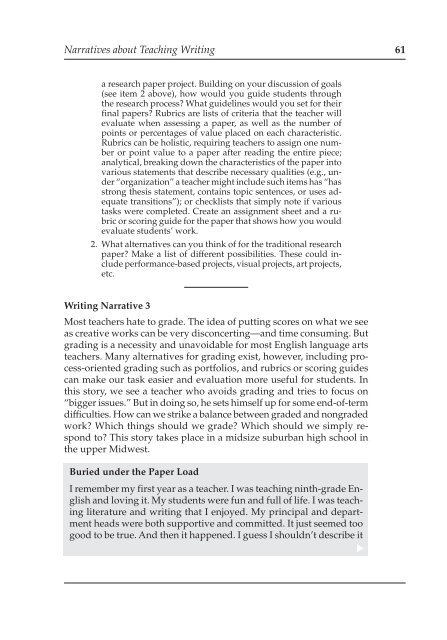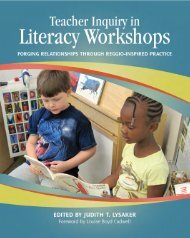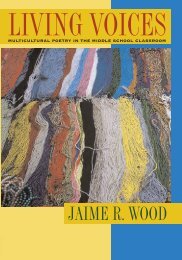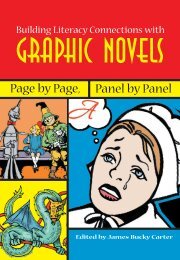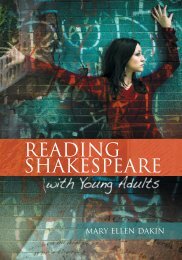2 Narratives about Teaching Writing - National Council of Teachers ...
2 Narratives about Teaching Writing - National Council of Teachers ...
2 Narratives about Teaching Writing - National Council of Teachers ...
- No tags were found...
You also want an ePaper? Increase the reach of your titles
YUMPU automatically turns print PDFs into web optimized ePapers that Google loves.
▲<strong>Narratives</strong> <strong>about</strong> <strong>Teaching</strong> <strong>Writing</strong> 61a research paper project. Building on your discussion <strong>of</strong> goals(see item 2 above), how would you guide students throughthe research process? What guidelines would you set for theirfinal papers? Rubrics are lists <strong>of</strong> criteria that the teacher willevaluate when assessing a paper, as well as the number <strong>of</strong>points or percentages <strong>of</strong> value placed on each characteristic.Rubrics can be holistic, requiring teachers to assign one numberor point value to a paper after reading the entire piece;analytical, breaking down the characteristics <strong>of</strong> the paper intovarious statements that describe necessary qualities (e.g., under“organization” a teacher might include such items has “hasstrong thesis statement, contains topic sentences, or uses adequatetransitions”); or checklists that simply note if varioustasks were completed. Create an assignment sheet and a rubricor scoring guide for the paper that shows how you wouldevaluate students’ work.2. What alternatives can you think <strong>of</strong> for the traditional researchpaper? Make a list <strong>of</strong> different possibilities. These could includeperformance-based projects, visual projects, art projects,etc.<strong>Writing</strong> Narrative 3Most teachers hate to grade. The idea <strong>of</strong> putting scores on what we seeas creative works can be very disconcerting—and time consuming. Butgrading is a necessity and unavoidable for most English language artsteachers. Many alternatives for grading exist, however, including process-orientedgrading such as portfolios, and rubrics or scoring guidescan make our task easier and evaluation more useful for students. Inthis story, we see a teacher who avoids grading and tries to focus on“bigger issues.” But in doing so, he sets himself up for some end-<strong>of</strong>-termdifficulties. How can we strike a balance between graded and nongradedwork? Which things should we grade? Which should we simply respondto? This story takes place in a midsize suburban high school inthe upper Midwest.Buried under the Paper LoadI remember my first year as a teacher. I was teaching ninth-grade Englishand loving it. My students were fun and full <strong>of</strong> life. I was teachingliterature and writing that I enjoyed. My principal and departmentheads were both supportive and committed. It just seemed toogood to be true. And then it happened. I guess I shouldn’t describe it


